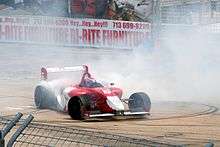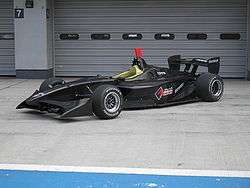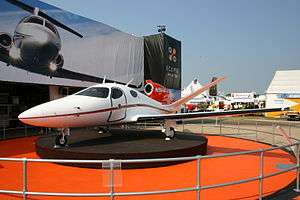Swift Engineering
 | |
| Private | |
| Industry | Aerospace/Aviation |
| Founded |
1983 california, USA |
| Headquarters |
San Clemente, California, United States 33°55′15″N 118°19′40″W / 33.9207°N 118.3278°WCoordinates: 33°55′15″N 118°19′40″W / 33.9207°N 118.3278°W |
Area served | Worldwide |
Key people |
|
| Products |
|
Number of employees | Approx. 80 |
| Subsidiaries | Swift Xi Inc. (60%) Japan |
| Website |
swiftengineering |
Swift Engineering is an American engineering firm, most notable for producing racing cars for a variety of open-wheel racing series, including Formula Ford, Formula Atlantic, the Champ Car World Series and Formula Nippon. From 2000 it diversified into Aerospace/Aviation markets.
History
Swift Cars was founded in 1983 by David Bruns, Alex Cross, R.K. Smith, and Paul White.[1] The first car, the DB-1, was a Formula Ford 1600 which won the SCCA National Championship in its debut race.[2] The company later built cars for Sports 2000, Formula Ford 2000, Formula Atlantic and CART. Swift chassis won the Atlantic Championship from 1989 to 1992 and British Formula Renault in 1990.
In 1991, Swift was purchased by Panasonic executive and Indycar racing driver Hiro Matsushita who renamed the firm Swift Engineering. Under his direction Swift moved up to the CART World Series from 1997 to 2000, with two cars entered by Newman/Haas Racing and driven by Michael Andretti and Christian Fittipaldi. In CART, Swifts got four wins and 24 podiums from 182 race entries. Tarso Marques was the last driver to race a Swift chassis in CART in the 2000 season.
In 1998, Swift became the sole supplier for the new spec regulation Toyota Atlantic Championship. In 2006, the Atlantic race series became a part of the Champ Car (formerly CART) organization and was renamed the Champ Car Atlantic Championship Powered by Mazda. Swift built an entirely new car for the series, using 016.a as a chassis code.
Swift became the sole supplier of chassis for the Japanese Formula Nippon championship in 2009 with the 017.n chassis (also known as the FN09).[3] An updated model called SF13 was used in 2013. A derivative of the 017.n, the 020.I, was proposed by the company in response to Indy Lights' requirement for a new chassis for the 2014 season.[4]
In 2018 Swift Engineering joint ventured with Kobe Institute of Computing called Swift Xi Inc in Kobe, Japan providing data, logistics, and operations of autonomous and robotic technologies.[5]
Racing cars

_FP2.jpg)
.jpg)
| Year | Car | Racing series |
|---|---|---|
| 1983 | Swift DB1 | Formula Ford 1600 |
| 1984 | Swift DB2 | Sports 2000 |
| 1988 | Swift DB4 | Formula Atlantic |
| 1989 | Swift DB3 | Formula Ford 2000 |
| 1990 | Swift DB5 | Sports 2000 |
| 1991 | Swift DB6 | Formula Ford 1600/2000 |
| 1997 | Swift 007.i | CART |
| 1998 | Swift 008.a | Formula Atlantic |
| 1998 | Swift 009.c | CART |
| 1999 | Swift 010.c | CART |
| 2000 | Swift 011.c | CART |
| 2002 | Swift 014.a | Formula Atlantic |
| 2006 | Swift 016.a | Formula Atlantic |
| 2009 | Swift 017.n | Formula Nippon |
Aviation
Killer Bee
After diversifying into aerospace/aviation markets, Swift Engineering designed, built and delivered the runway-independent Killer Bee blended wing UAV and its mobile launch/retrieval system in 2002. Northrop Grumman bought the Killer Bee UAV product line from Swift Engineering, and was renamed Northrop Grumman Bat in April 2009.[6]
Eclipse 400
In 2007 Swift Engineering produced the prototype Eclipse 400 single engine jet aircraft under contract to Eclipse Aviation. The aircraft was built in secrecy at NASA's Wallops Flight Facility in Virginia and first flown on 2 July 2007.[7] Swift supplies high-strength, low-weight composite parts and assemblies to a number of aerospace industry customers. Engineering consultancy and the design and production of tooling for composite parts are further aspects of the business.
Swift020
The Swift020, the first UAS featuring X-blade technology. It takes off and lands anywhere like a quad-rotor and transitions to efficient fixed-wing forward flight without additional launch and recovery equipment allowing it to vastly reduce operational time and cost.[8][9] It has a 4m wingspan, 2-3 hours endurance and a 1-1.5 kg payload. It runs on all-electric power and fully autonomously.
Recognitions
In 2012 Swift Engineering received the JEC Americas Innovation Award for its out of autoclave process[10] and in the same year Northrop Grumman Small Business Supplier of the Year, awarded from 1500 suppliers. In 2013 Swift Engineering has been chosen as a “Best in Class” A&D Company to Watch by Aviation Week[11] Swift Engineering Inc. was awarded “Best Intrapreneurship” by OCTANe, Orange County’s technology and life sciences accelerator organization, during the annual High Tech Innovations event held Oct. 13 2017 in Newport Beach, CA.[12]
References
- ↑ "Rekindling The Flame". Archived from the original on August 25, 2006.
- ↑ "First Win PR" (PDF). Archived from the original (PDF) on 2011-07-07.
- ↑ "2009 Formula Nippon cars to be made in USA".
- ↑ Pruett, Marshall (August 28, 2012). "INDYCAR: Swift Files 2014 Indy Lights Proposal". SPEED Channel. Fox Sports. Archived from the original on August 30, 2012. Retrieved 2012-08-29.
- ↑ http://swift-xi.com/index.html
- ↑ https://www.airforce-technology.com/projects/northropgrummanbat/
- ↑ Trautvetter, Chad (July 2007). "Eclipse Goes Solo with Concept Jet". Retrieved 2008-11-15.
- ↑ https://swiftengineering.com/swift020/
- ↑ https://dronelife.com/2017/04/29/49104/
- ↑ http://www.jeccomposites.com/about-jec/press-releases/jec-innovation-awards-program-2012-13-companies-rewarded-their-composite
- ↑ http://archive.aviationweek.com/issue/20131111
- ↑ http://eecatalog.com/military/2017/11/02/swift-engineering-inc-awarded-by-octane-for-best-intrapreneurship-2017/
External links
| Wikimedia Commons has media related to Swift racing cars. |
- Swift Engineering web site
- SWIFT020
- Road and Track road test of the Swift DB-1 Formula Ford
- The Bridge

